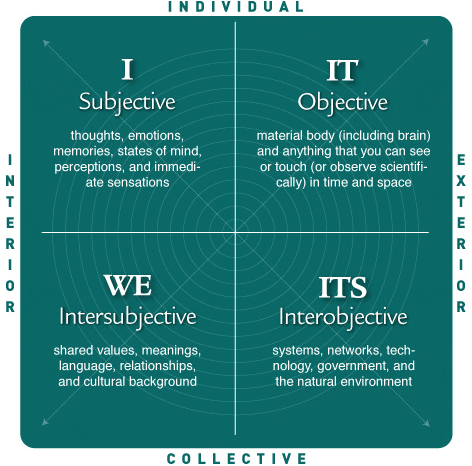Introducing the integral model
I’m writing posts about ‘the journey of consciousness’ primarily because of a book I’m reading, Paul R. Smith’s Integral Christianity: The Spirit’s Call to Evolve (2011). Despite the rather gaudy cover, it’s one of the best ‘big picture’ books on Christianity I’ve read for some time. At least, for me, it’s very timely.
As the contemplative writer and teacher, Cynthia Bourgeault, writes in her review of the book:
…this is the first attempt to systematically apply [Ken] Wilber’s integral paradigm to Christian faith and practice. It works not only because [Smith] understands Wilber very well, but because he knows Christianity like the back of his hand. It’s doubly credible because he writes not from the standpoint of an academic theologian, but as a committed Christian pastor who has tested every one of these principles in actual parish ministry… (1)
Who is Ken Wilber and what is the ‘integral paradigm’?
Ken Wilber is a contemporary American theorist and visionary thinker who has been writing about the evolution of consciousness for many years. He has a great gift for reading very broadly and deeply, across a vast range of fields - biology, neuroscience, history, religion and spirituality, economics, psychology and psychotherapy, cultural studies - and for synthesizing many complex ideas into a comprehensive and clear ‘world theory’. In addition, he’s a committed spiritual practitioner who is widely acquainted with, and sympathetically disposed to, a wide range of mystical and wisdom traditions.
Being a human being, Wilber is flawed and imperfect. Some have criticized his “transpersonal” vision as being too intellectual and hierarchical. Some have also criticised the ‘cult of Wilber’ associated with his ‘Integral Institute’ and ‘Integral Life Practice’. For an appreciation and a critique, see Mark Manson, “The Rise and Fall of Ken Wilber”.
Integrating previous developmental ideas into one clear, elegant model, Wilber attempts a comprehensive theory of consciousness that can be applied to any individual, tradition, world culture, religion, or field of study.
His ‘integral’ or comprehensive model consists of five main elements:
States of consciousness: Consciousness understood as various states, including basic states of waking, dreaming, and deep sleep, variations on these (day-dreaming, reverie, desensitized and dissociative states), meditative states (induced by deep relaxation, contemplative prayer, breath awareness etc.), altered states (e.g. drug-induced), and peak experiences (“many of which can be triggered by intense experiences like making love, walking in nature, or listening to exquisite music”). (2). States of consciousness come and go, are impermanent, and tend to be interpreted according to the stage or level of consciousness that a person is up to at the time (see below). That said, various states of consciousness can support forward movement and helpful shifts in terms of our spiritual journey (which is the point, after all, of regular spiritual practice). Accessing deeper states of consciousness, including an immersion in the presence of God, supports and inspires us to heal, ‘wake up’, and grow. The opposite is also true: some states impair or restrict our growth.
Stages of consciousness (or levels of development): this is the aspect of integral theory that Paul Smith’s book begins with and surveys in terms of Christianity. I will say more about this in the next post. For now, it is the idea that consciousness - like our physical bodies and psychological selves - develops through various sequential stages (also called “levels” or “altitudes” in integral theory). A key integral insight is that “leaps in evolution usually occur in a manner of transcending and including, not by wiping out what came before.” (3).
Lines of development: include the “multiple intelligences” that people exhibit, such as cognitive, interpersonal, emotional, moral, psychosexual, and spiritual “intelligence”, and which continue to grow and develop through various stages or levels.
Types of consciousness: includes ‘feminine’ (tending to be based on relationship, care, and responsibility) and ‘masculine’ (tending to be based on autonomy, justice and rights) modes of consciousness, as well as our preferred styles of perceiving and evaluating our interior and exterior worlds (for example, Jung’s various psychological “types”, Myers-Briggs’ personality types). Crossing over between states and types of consciousness, are different “bodies” - or different layers of embodied conscious reality - that we find through the world’s various wisdom traditions. These include states of consciousness as perceived through the physical or “gross body” (i.e. physical experiences of waking life), states of consciousness as experienced through the “subtle” or “energy body” (such as dreams, visions, and inner feelings and sensations), and consciousness as resting in the awareness of being, of vast luminous emptiness or presence, and as formless oneness with God and Reality (consciousness as perceived through the “causal”, “non-dual”, and “spiritual” bodies). (4)
The integral quadrant or quadrants: This is the most explicitly “comprehensive” part of Wilber’s theory:
All reality, Wilber argues, has these four simultaneous, “ever-present, ubiquitous” dimensions. All reality is a latticework of exterior, interior, singular and plural; I, We, It, Its. A truly comprehensive theory of consciousness, culture, and reality, will therefore include and address all four quadrants. For this reason the integral model is sometimes summarised as “AQAL” - “all quadrants, all levels, all lines, all states, all types”.
(If you’d like to see and hear Ken Wilber offering a brief summary of the five elements, click here. For another solid introduction to integral theory, go here ).
Putting it altogether (gulp!), human consciousness might be mapped as something like this:
Don’t panic if this image above is instantly overwhelming, feels dry or energetically dead. We are a long way from John Constable’s showery skies!
In the coming posts, I want to tease out some material from Paul Smith’s Integral Christianity, looking at how the development of the Christian worldview and theology (the “We” or bottom left quadrant) goes along with the development of certain social systems and ‘churches’ (bottom right quadrant) and individual senses of self (upper left quadrant), while completely ignoring the upper right quadrant (or perhaps not, who knows).
Yes, this can look overwhelming and obsessive, but it comes alive, for me, when I apply it to my religious experience and journey (Christianity), as well as my professional practice and development (as a psychotherapist, witnessing how people grow, ‘transcend and include different stages of consciousness, which ‘states’ and ‘bodies’ they regularly access or remain blocked off from, what ‘lines’ they are more or less practised in, as well as what types of consciousness they prefer or remain less developed). Until then, until it comes alive in application to lived experience, this post (and perhaps the next one, too) is really about introducing a new vocabulary.
The most exciting thing about the integral model, perhaps, is that it suggests our consciousness and spiritual journey is evolving ever further, and gives us some words and basic categories for thinking about this exciting prospect. We don’t have to confine our spiritual lives to ‘getting back to Jesus’, or ‘getting back to how the first apostles lived and preached’. We don’t have to battle over which (Christian) church or doctrine is the best one - or, indeed, which religion or spirituality is the best one. We don’t have to ‘settle’ with this or that familiar but boring plateau of faith, and put our energy into helping others join our flat boring plateau, too.
Suddenly, a future horizon opens and beckons.
It would be easy to run away with the intellectual and spiritual excitement of it all. In truth, I see very little evidence that those in the Christian “We” quadrant are hearing this call - “the spirit’s call to evolve” - and responding in courageous and creative ways. Quite the opposite, at least in my neck of the woods: most churches seem to treat ‘secularism’ as a great enemy (if only we could get back to nineteenth century church attendence numbers…), or ‘postmodernity’ as a beautiful single woman to be approached and courted, as if traditional Christianity has all the answers and just needs the opportunity to present its credentials afresh.
Hand on heart, the majority of my spiritual growth in the last fifteen years of returning to church has come outside of the “Christian We” (the conventional bricks-and-mortar church and faith community). In truth, in the last fifteen years, I can’t think of many important spiritual experiences or transformative ‘states of consciousness’ (and there have been many in my life more broadly), or valuable, growth-supporting encounters or conversations (and there have been some), or stage “including and transcending” shifts (apart from a gradual and sometimes grumpy awareness of what isn’t working anymore, and yet our gathering still intensifies an infinite presence we can barely feel or name) that have actually occured in ‘church’ (and I have been a more-than averagely committed member of four different churches in the last fifteen years).
At least for someone of my age and stage, and spiritual inclination, it seems that traditional church might be one of the last places where someone might encounter the Spirit.
What on earth is going on? And can Paul Smith, with assistance from Ken Wilber, perhaps point us towards some answers to this question.
References
(1) Paul R. Smith, Integral Christianity: The Spirit’s Call to Evolve (2011), ii.
(2) Ken Wilber, The Integral Vision (2007), p.28.
(3) Mark Manson, “The Rise and Fall of Ken Wilber” (2025).
(4) Wilber, The Integral Vision (2007), pp.53-56.


